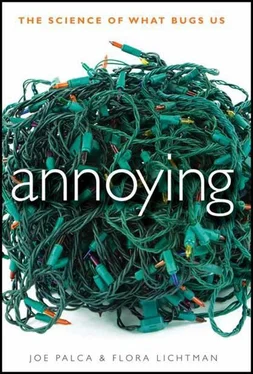Huntington’s patients indicate what happens to annoyance when the brain breaks down, but what accounts for annoyance in healthy brains?
It was 10:53 on a Tuesday morning, and Patti wasn’t going to make it to the lab on time. She’d stayed up late the night before and then slept through the alarm. The year was 2006, and Patti was a sophomore at the University of Southern California. It wouldn’t be unfair to call Patti a typical college sophomore. She wasn’t a star student, but she managed a B+ average, spiking the occasional A in English because she was a pretty good writer.
She hadn’t decided on a major but was leaning toward psychology. That’s why she’d signed up to be a subject in the psych experiment she was running late for. She was supposed to be at the cognitive neuroimaging center over by the SeelyMudd building at eleven to have her brain scanned.
Tom Denson, a graduate psych student, was running the experiment. Denson led one of the sections in Patti’s intro psych class. She saw an ad he had placed on the department’s Web site looking for participants in a study he was doing on cognitive ability and mental imagery.
Two weeks earlier, she had been to Denson’s office to answer a long set of questions. It was the kind of personality stuff she recognized from the intro psych course: Do you get along with others? Do you like to show off? Do other people misunderstand you? Do you worry about what people think of you? “He just wants to know how neurotic I am,” Patti thought.
Some of the agree-disagree items were a little more unexpected: I get into fights more than the average person. Sometimes I fly off the handle for no good cause. When things don’t go the way I plan, I take out my frustration on the first person I see. If I have had a hard day at work or school, I’m likely to make sure everyone knows about it. “What’s he getting at there?” she wondered at the time.
On this morning, however, she wasn’t thinking about those questions. All she was thinking about was getting to the imaging center by eleven, and she wasn’t going to make it. At ten past eleven, she blew in the front door and went to the room where Denson had told her to meet him. He was a thinnish, gangly man with glasses. He didn’t seem annoyed that she was late, but he was anxious to get started. He handed her a clipboard. On the clipboard was a list of words. Next to each word were the numbers 1 to 5. “Before we do the scanning stuff, I want to see how you’re feeling today. Rate your feelings on each of these words, where 1 is ‘not at all’ and 5 is ‘extremely.’”
There were about sixty-five words on the list, adjectives such as alert , angry , considerate , shaky , and sad . It took her about two minutes to jot down her ratings. “Right, let’s head over to the lab,” said Denson.
The lab was in the adjacent room. From the control room, Patti could see the magnetic resonance imaging machine through the open door. It resembled a huge, thick white donut. Sticking out of the hole in the center of the donut was a thin platform, like the gangplank into a ship.
Patti knew the basics of how an MRI worked. The device contained a huge, powerful magnet that produced a strong electromagnetic field. When the magnet was pulsed on and off, it caused the protons in water molecules to change their orientation, a change that the device could detect. By adjusting the orientation of the magnetic field, computers could build a three-dimensional picture of the tissue structure of whatever was in the scanner. Today, that tissue would be Patti’s brain.
She’d looked at the safety material Denson had sent her. She knew there was no health risk from getting the scan. The only real risk was if she got near the magnet with anything metal in her pockets or, even worse, anything metal inside her—say, a metal pin to hold a broken bone together. The magnet could rip that pin out of her body.
She remembered one caution that amused her: “It is a good idea not to wear eye makeup—tiny metal bits in mascara, for example, can move in the magnetic field and irritate your eyes.” {48} 48 1. Dana and David Dornslife, Cognitive Neuroscience Imaging Center, http://brainimaging.usc.edu/index.php?topic=forsubjects .
“One advantage of being late,” she thought. “No time for makeup this morning.”
“Here’s the drill,” Denson told her. “You’ll lie down in the machine. You’ll have on a pair of headphones. Try to keep your head as still as possible. You’ll be able to see a small screen above your head. Jumbled-up letters will appear on the screen. Your job is to tell me what word the letters spell when you put them in the right order.”
“So you want me to solve the anagrams?” she asked.
“Exactly,” said Denson. “There’s a microphone inside the MRI. I’ll be able to hear your answers. You have fifteen seconds to solve each anagram. If you don’t know the answer, just say ‘No answer.’ Clear?”
“Clear.”
“But before we start showing you the anagrams, we’ll take a baseline scan. All you have to do is lie there.”
“I think I can handle that,” Patti said.
“Then let’s get started.”
She put on the headphones and lay down on the gangplank. Her head was resting in a plastic cage with foam sides that helped keep her head from moving. Denson left the room and the gangplank retracted into the machine. It stopped when Patti’s entire torso was inside the machine, with only her legs sticking out.
“Can you hear me?” Denson asked.
“Loud and clear,” she replied.
“Good,” he said, “and I can hear you, too. So, here we go with the baseline run. Just lie still.”
The silence that had engulfed her inside the machine was replaced by a whirring sound and then intermittent banging. The banging came on again and stayed on.
“What’s that sound?” Patti asked.
“It’s the sound the machine makes when it’s running,” said Denson. “Sorry, there’s nothing we can do about that. Just lie quietly while we take a baseline measurement.”
She lay still, thinking that the banging would become annoying after a while. After five or six minutes, she heard Denson’s voice in her ear again. “Now we’re ready to start the experiment. Here come the anagrams. Remember, you’ll have fifteen seconds to solve each one. You’ll hear a beep when the time is up. Either say what the unscrambled word is or say, ‘No answer.’ Be sure to speak in a loud voice so I can hear you. I’ll record your answers here in the control room. Here we go.”
The screen went dark, and then the letters “zapzi” appeared on the screen. “Pizza,” Patti said after a few seconds.
The next anagram appeared: sems. This one took a little longer, but Patti got it before the beep. “Mess,” she said.
“You’ll have to speak up, I can’t hear you,” she heard Denson say over her headphones.
“Mess,” she repeated more loudly.
The next couple of anagrams were pretty easy. Then came “auletenitn.” Patti stared at the letters. She mentally flipped them around, but nothing was coming. The beep sounded. “No answer,” she said.
“I thought I told you to speak up,” she heard Denson say.
“No answer!” she said again, this time practically shouting. “Can’t they get their own equipment to work?” she fumed to herself.
The letters “neentroivmn” appeared on the screen. “Cripes, I have no idea,” she thought. “I wish that banging would stop.” The beep sounded again.
“No answer,” she said loudly.
“Speak up,” Denson said in her ear. “Look, this is the third time I have had to say this!” He sounded pissed off. “Can’t you follow directions?”
Читать дальше












